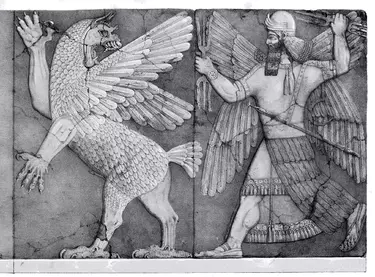 Chaos Monster and Sun God
Chaos Monster and Sun God
Welcome to the fascinating world of Babylonian astrology, the first known organized system of astrology that emerged in the second millennium BC. In this article, we will explore the rich history, beliefs, and practices of the ancient Mesopotamians. So, grab your seat and prepare to be captivated by the wonders of Babylonian astrology!
Early Origins
Speculation suggests that astrology in some form appeared during the Sumerian period in the 3rd millennium BC. However, the isolated references to ancient celestial omens of this period are not enough evidence to demonstrate an integrated theory of astrology. The real history of scholarly celestial divination is generally believed to begin with late Old Babylonian texts around 1800 BC. By the 16th century BC, the extensive use of omen-based astrology was evident in the compilation of a comprehensive reference work known as Enuma Anu Enlil. This work consisted of 70 cuneiform tablets comprising 7,000 celestial omens. It was during this time that Babylonian astrology became more precise and sophisticated.
Divinatory Basis
The Babylonians practiced astrology as a means to ascertain the will and intentions of the gods. They believed that the movements and positions of celestial bodies held significance and conveyed messages from the divine. For instance, they interpreted blemishes and marks found on sacrificial animals' livers as symbolic signs from the gods. These signs were believed to represent the gods' discontent or disturbance. The Babylonians would then try to appease the gods and find ways to fulfill their expressions without causing harm to the king and the nation.
Planets and Gods
The Babylonians associated certain gods with specific planets. Marduk, the patron god of Babylon, was recognized as the planet Jupiter. Other associations included Venus with the goddess Ishtar, Saturn with Ninurta (Ninib), Mercury with Nabu (Nebo), and Mars with Nergal. The movements of the Sun, Moon, and five planets were believed to represent the activity of these gods and their influence on Earth.
System of Interpretation
The Babylonian priests developed a system of interpreting celestial phenomena, which extended from the Moon, Sun, and planets to the fixed stars. Interpretations were based on past observations and associations of ideas. For example, if the rise of the new moon in a cloudy sky was followed by victory over an enemy or abundant rain, it was considered a favorable sign. On the other hand, the appearance of the new moon earlier than expected was seen as unfavorable. These interpretations formed a guide for the priests and were considered an essential tool for making predictions.
Astral Medicine
Astrology played a crucial role in a practice known as astral medicine. The Babylonians believed that specific remedies could be used for different ailments based on the date. For example, on Aries days, sheep blood, fat, and hair were anointed, while on Capricorn days, goat blood, fat, and hair were used. It is debated whether astral medicine was purely theoretical or actually practiced by the Babylonians. Nonetheless, it sheds light on their holistic approach to healing and their belief in the influence of celestial events on everyday life.
Astrology and the Calendar
The Babylonians closely integrated astrology with their calendar. When creating the calendar for the next month or year, they considered important festivals and religious activities. The months were divided into groups of three, alternating among the lands of Elam, Amurru, Subartu, and Akkad. The movements of the Sun, Moon, and planets were incredibly significant, as they were believed to shape the Babylonians' lives and the world around them. Lunar omens, particularly eclipses, played a central role in their calendar and religious practices.
Limits of Early Knowledge
Early Babylonian astrology had its limitations. It focused primarily on public welfare and the well-being of the king, rather than individual horoscopes. The astronomical knowledge of the Babylonians was empirical but limited and flawed. It wasn't until the Seleucid period, after the advent of the Greeks in the Euphrates Valley, that Babylonian astronomy made significant advancements. Despite these limitations, the Babylonians recognized the reign of law and order in celestial movements, which paved the way for a more methodical approach to divination.
Ashurbanipal: The Scholarly King
King Ashurbanipal of Assyria, who reigned from 668 to 625 BC, was famous for his great library of cuneiform tablets in Nineveh. These tablets covered various subjects, including astrology, history, mythology, and science. Ashurbanipal's astrologers, such as Rammanu-sumausar and Nabu-musisi, had developed expertise in deducing omens from celestial movements. Their reports on the occurrences in heaven and earth served as valuable political tools for the king's decision-making process. Unfortunately, the library was destroyed or dispersed after Nineveh fell to the Medes and Chaldean Babylonians.
The world of Babylonian astrology is a captivating realm filled with ancient wisdom, beliefs, and practices. It provides a unique glimpse into the early understanding of the cosmos and its influence on the lives of the Mesopotamians. Reflecting on the complexities and mysteries of the ancient past, we can appreciate the enduring curiosity and human desire to decode the secrets of the universe.
References:
- Baigent, Michael. From the Omens of Babylon: Astrology and Ancient Mesopotamia.
- Holden, James Herschel. A History of Horoscopic Astrology.
- Koch-Westenholz, Ulla. Mesopotamian Astrology.
- Neugebauer, Otto. The Exact Sciences in Antiquity.
- Rochberg, Francesca. Babylonian Horoscopes.
- Verderame, Lorenzo. "The Primeval Zodiac: Its Social, Religious, and Mythological Background."
 Detail of the Ishtar Gate in Babylon
Detail of the Ishtar Gate in Babylon

















